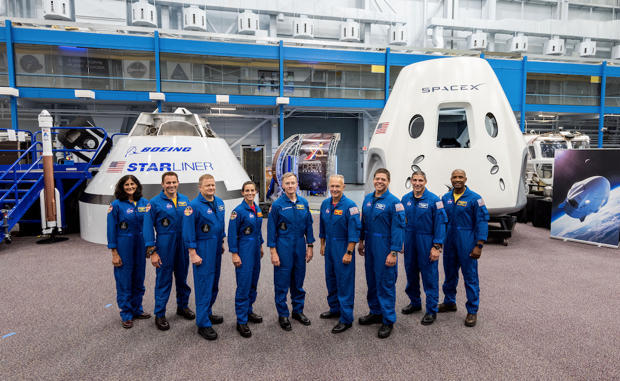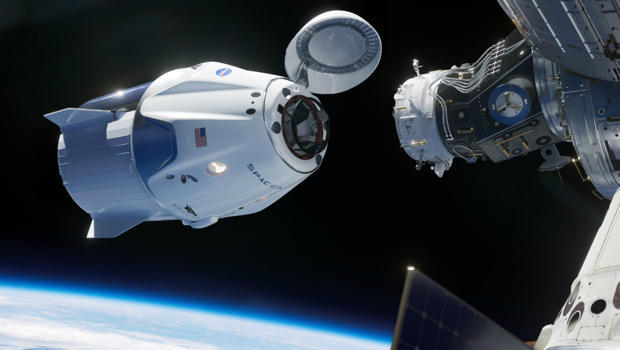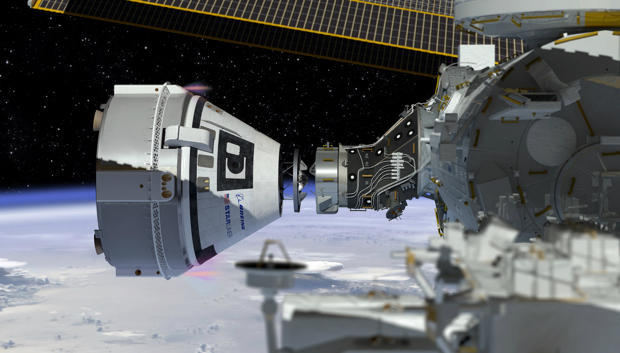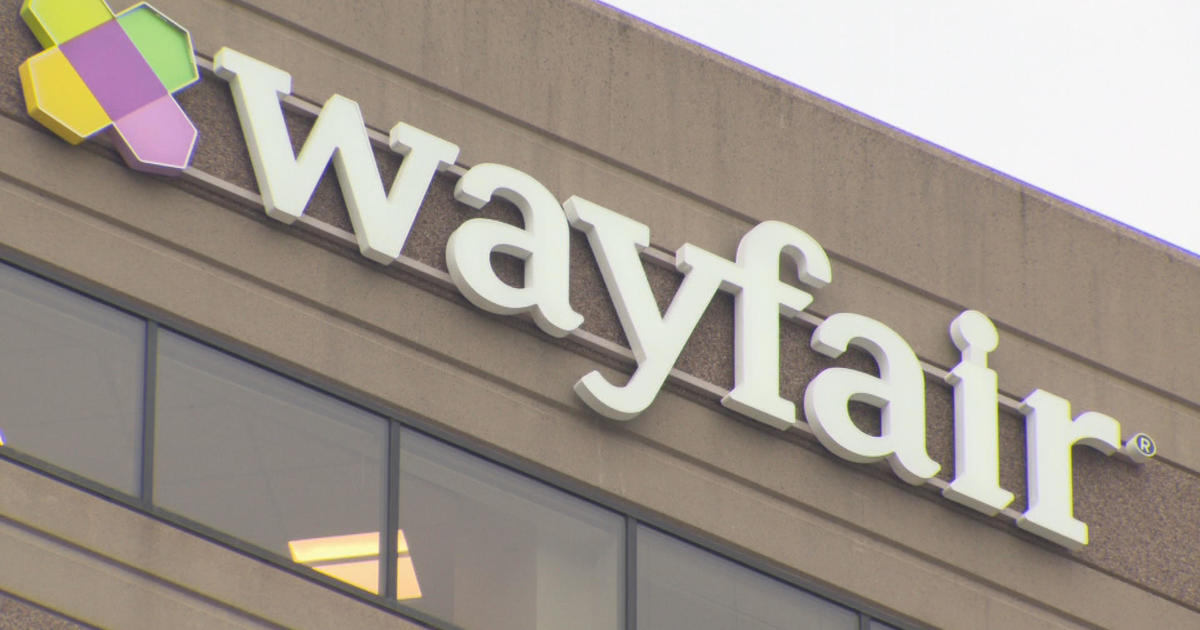NASA names crews for first Boeing, SpaceX launches to space station
NASA named nine astronauts Friday who hope to blast off next year on flights to the International Space Station aboard commercial ferry ships built by Boeing and SpaceX. The flights will be the first piloted launches to orbit from the United States since the space shuttle program ended in 2011.
"We're delivering on the critical task of providing the capability to fly our crews on a U.S.-built rocket and spacecraft from U.S. soil on Florida's Space Coast to the International Space Station so we no longer have to rely on our Russian partners to get our crews to space," said former shuttle commander Robert Cabana, director of the Kennedy Space Center.
Four of the astronauts -- Eric Boe, Douglas Hurley, Robert Behnken and Sunita Williams -- were named earlier but they were not assigned to specific flights or vehicles. The expanded nine-member commercial crew cadre now features six spaceflight veterans, including Chris Ferguson, commander of that final shuttle mission and now a Boeing vice president, and three rookies. Two of the nine are women.
SpaceX's crewed Dragon capsule will launch atop the company's Falcon 9 rocket from pad 39A at the Kennedy Space Center. Boeing's CST-100 "Starliner" will be blasted to orbit by United Launch Alliance Atlas 5 rockets from pad 41 at the nearby Cape Canaveral Air Force Station.
Boeing and SpaceX both plan one unpiloted test flight before the astronauts climb on board. SpaceX is targeting late November for its first test flight while Boeing is expected to launch in late December or January.
The first piloted test flights are expected next spring. Target dates have not yet been determined, but if no major problems crop up, SpaceX may be ready to fly by the April timeframe with Boeing following suit a month or so later.
"For the first time since 2011, we are on the brink of launching American astronauts on American rockets from American soil," NASA Administrator Jim Bridenstine told a packed auditorium at the Johnson Space Center. "And now it's time to meet the brave Americans who will be flying on these spacecraft developed right here in the United States."
For Boeing's CST-100 debut, whenever it occurs, Ferguson will be on board, joined by former shuttle pilot Eric Boe and rookie astronaut Nicole Mann, a former Navy F/A-18 pilot.
Ferguson, a respected veteran of three shuttle missions, helped lead Boeing's CST-100 development and was widely expected to fly aboard its first test flight. He said both new spacecraft offer a major improvement over the space shuttle he flew in 2011: a powerful abort system designed to pull a crew to safety at any point during the climb to space.
"I think what we really see now is a much greater emphasis on safety," he said. "We're returning to a full capability ascent abort system to keep astronauts safe all the way through (launch), and that's something the shuttle didn't have."
Boe is one of the original four astronauts assigned to the commercial crew program while Mann is a space rookie. But she logged more than 2,500 hours of flying time as a Naval aviator, including 200 carrier landings and 47 combat missions over Iraq and Afghanistan.
"It's absolutely an opportunity of a lifetime," Mann told Bridenstine. "I couldn't be more excited to join the NASA-Boeing team, to be involved in the test and development and then to be there on launch day and to experience the results of all that hard work. It's going to be a proud moment for the team, it's going to be a proud moment for America.
"As a test pilot, it doesn't get any better than this!"
SpaceX's first crewed launch of its human-rated Dragon spacecraft will feature former chief astronaut Bob Behnken, veteran of two shuttle flights, and Douglas Hurley, Ferguson's co-pilot for the final shuttle mission. Both were part of the original group of four commercial crew astronauts.
"The first flight (of a new vehicle) is something you dream about as a test pilot, and you don't think it's ever going to happen to you," Hurley said. "Bob and I are extremely excited to put Dragon through its paces in space and get to the International Space Station again. ... It's going to be fun."
Behnken said he looked forward to flying the more automated Dragon, a welcome relief compared to the complexity of the space shuttle.
"There were about 3,000 switches inside (the shuttle) and there was no situation that the astronauts couldn't make worse by touching the wrong switch at the wrong time," he said. "We're grateful that the next vehicle we're going to fly on is going to be a little bit more automated."
"It's like flying an iPhone, right?" Bridenstine asked, referring to the glass cockpit architecture.
"It is absolutely like flying the iPhone," Behnken said. "I look forward, sir, to getting you (to the SpaceX factory) and maybe you can sit next to us in the cockpit and maybe go through flying the iPhone to dock to space station."
The second, presumably operational, CST-100 flight will include Sunita Williams, one of the original four and one of NASA's most experienced astronauts with 322 days in space during two station stays, and astronaut Josh Cassada, a rookie who holds a doctorate in particle physics.
SpaceX's second piloted launch will include station veteran Mike Hopkins and rookie astronaut Victor Glover, a former F/A-18 test pilot with more than 2,000 hours flying time, more than 400 carrier landings and 24 combat missions.
"I'm just grateful to God and to my family and to our leadership for the opportunity to work for NASA, period," Glover said. "To work and live in space is a humbling and amazing blessing in and of itself. And now to have the opportunity to work with these great companies on something that is so important to our nation and to NASA, this is the stuff of dreams."
NASA currently plans to launch two commercial crew flights per year through the life of the station program to carry at least four U.S. and partner astronauts representing the European, Japanese and Canadian space agencies into orbit at a time. The Russians will continue launching two Soyuz missions each year to carry cosmonauts and, possibly, space tourists to the lab.
Contrary to widespread belief, the resumption of U.S. piloted flights to the ISS will not mean the end of NASA seats aboard the Soyuz.
That's because station crews launch and return to Earth on the same vehicle. If a NASA astronaut fell seriously ill, for example -- and if Americans were no longer launching aboard the Soyuz -- a commercial crew ship would have to carry all of its astronauts back to Earth at the same time, leaving no one aboard qualified to operate the lab's U.S. systems.
The same would be true if a Soyuz had to depart unexpectedly, leaving no one to operate the station's Russian segment.
By launching an astronaut aboard each station-bound Soyuz, and a cosmonaut aboard each U.S. commercial crew ship, that contingency would be covered. Should ether segment of the station have to be evacuated, at least one astronaut or one cosmonaut would be aboard to operate critical systems. Assuming, of course, the station remained habitable after whatever forced an evacuation.
The near-term problem for NASA is its current contract with Roscosmos, the Russian space agency, for U.S. seats aboard Soyuz spacecraft while the commercial crew program is getting off the ground. Downstream contingency planning aside, the current contract runs through a final July 2019 launch. It takes three years to build a Soyuz vehicle and there are no more immediately available unassigned seats.
At least one of the U.S. commercial crew providers must be flying by mid 2019 or shortly thereafter to maintain an uninterrupted crew rotation schedule.
Discussions are underway to possibly secure one more seat on a Soyuz if possible. NASA also has the option of turning Boeing's first piloted test flight into an operational mission. In that case, the crew would remain at the station for six months instead of the 10 days to two weeks originally planned for a test flight.
However it plays out, the commercial crew program is a critical next step in the private-sector development of low-Earth orbit.
In the wake of the 2003 Columbia disaster, the Bush administration ordered NASA to finish the space station and retire the shuttle by the end of the decade and to build new rockets and capsules to return astronauts to the moon in the early 2020s.
The Obama administration canceled NASA's Constellation moon program, directing the agency to focus instead on building a powerful new rocket to carry astronauts beyond the moon and, eventually, to Mars. At the same time, the administration opted to develop commercial spacecraft to ferry astronauts to and from the space station.
A NASA-funded competition began 2011 and on Sept. 16, 2014, the agency announced that Boeing and SpaceX would share $6.8 billion to develop independent space taxis, the first new U.S. crewed spacecraft since the shuttle.
SpaceX, under a $2.6 billion contract, is building a crewed version of its Dragon cargo ship that will ride into orbit atop the company's Falcon 9 rocket and return to Earth under parachutes for an ocean splashdown. The Falcon 9 has suffered two failures to date, one during a space station resupply launch and another during a ground test.
SpaceX holds NASA contacts valued at more than $2 billion for 20 space station resupply missions using unpiloted Dragon capsules and another contract, for an unspecified amount, for another six cargo flights. Dragon capsules are reusable and the company plans to use the same capsules for both types of missions, removing seats and cockpit displays for cargo missions.
Boeing is designing a more traditional Apollo-style capsule under a $4.2 billion contract that would use parachutes and airbags for ground landings in the western United States. The Boeing CST-100 will rely on ULA's Atlas 5 rocket for the trip to orbit, a workhorse booster with a perfect flight record that has been used primarily to launch U.S. military satellites and NASA planetary probes. ULA is a partnership between Boeing and Lockheed Martin.
Both capsules can carry up to seven astronauts, although four-person station crews are envisioned with the extra space going to cargo. Both companies also are exploring possible non-station commercial use.
NASA's Commercial Crew Transportation Capability (CCtCAP) contracts with Boeing and SpaceX call for up to six piloted test flights of the Crew Dragon and CST-100 crew capsules. Both companies also plan to market purely commercial rides to space for non-NASA customers.







